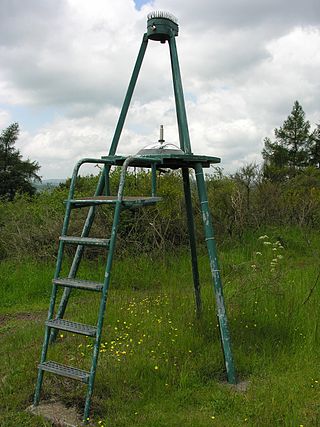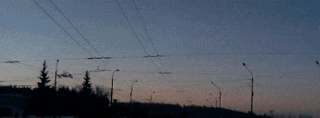Related Research Articles

A meteorite is a rock that originated in outer space and has fallen to the surface of a planet or moon. When the original object enters the atmosphere, various factors such as friction, pressure, and chemical interactions with the atmospheric gases cause it to heat up and radiate energy. It then becomes a meteor and forms a fireball, also known as a shooting star; astronomers call the brightest examples "bolides". Once it settles on the larger body's surface, the meteor becomes a meteorite. Meteorites vary greatly in size. For geologists, a bolide is a meteorite large enough to create an impact crater.

A meteor, known colloquially as a shooting star or falling star, is the visible passage of a glowing meteoroid, micrometeoroid, comet or asteroid through Earth's atmosphere, after being heated to incandescence by collisions with air molecules in the upper atmosphere, creating a streak of light via its rapid motion and sometimes also by shedding glowing material in its wake. Although a meteor may seem to be a few thousand feet from the Earth, meteors typically occur in the mesosphere at altitudes from 76 to 100 km. The root word meteor comes from the Greek meteōros, meaning "high in the air".

Meteor Crater, or Barringer Crater, is an impact crater about 37 mi (60 km) east of Flagstaff and 18 mi (29 km) west of Winslow in the desert of northern Arizona, United States. The site had several earlier names, and fragments of the meteorite are officially called the Canyon Diablo Meteorite, after the adjacent Canyon Diablo.

Ernst Florens Friedrich Chladni was a German physicist and musician. His most important work, for which he is sometimes labeled the father of acoustics, included research on vibrating plates and the calculation of the speed of sound for different gases. He also undertook pioneering work in the study of meteorites and is regarded by some as the father of meteoritics.

A bolide is normally taken to mean an exceptionally bright meteor, but the term is subject to more than one definition, according to context. It may refer to any large crater-forming body, or to one that explodes in the atmosphere. It can be a synonym for a fireball, sometimes specific to those with an apparent magnitude of −4 or brighter.

Meteoric iron, sometimes meteoritic iron, is a native metal and early-universe protoplanetary-disk remnant found in meteorites and made from the elements iron and nickel, mainly in the form of the mineral phases kamacite and taenite. Meteoric iron makes up the bulk of iron meteorites but is also found in other meteorites. Apart from minor amounts of telluric iron, meteoric iron is the only naturally occurring native metal of the element iron on the Earth's surface.

The Tagish Lake meteorite fell at 16:43 UTC on 18 January 2000 in the Tagish Lake area in northwestern British Columbia, Canada.

Petrus Matheus Marie (Peter) Jenniskens is a Dutch-American astronomer and a senior research scientist at the Carl Sagan Center of the SETI Institute and at NASA Ames Research Center. He is an expert on meteor showers, and wrote the book Meteor Showers and their Parent Comets, published in 2006 and Atlas of Earth’s Meteor Showers, published in 2023. He is past president of Commission 22 of the International Astronomical Union (2012–2015) and was chair of the Working Group on Meteor Shower Nomenclature (2006–2012) after it was first established. Asteroid 42981 Jenniskens is named in his honor.

The Peekskill meteorite is the object resulting from a well-documented meteorite event that occurred in October, 1992, in Peekskill, New York, United States. Sixteen separate video recordings document the meteorite burning through the Earth's atmosphere, whereupon it struck a parked car in Peekskill. The Peekskill meteorite is an H6 monomict breccia; its filigreed texture is the result of the shocking and heating following the impact of two asteroids in outer space. The meteorite is of the stony variety, and approximately 20% of its mass is tiny flakes of nickel-iron. When it struck Earth, the meteorite weighed 27.7 pounds (12.6 kg) and measured one foot in diameter. The Peekskill meteorite is estimated to be 4.4 billion years old.
The Great Daylight Fireball was an Earth-grazing fireball that passed within 57 kilometres of Earth's surface at 20:29 UTC on August 10, 1972. It entered Earth's atmosphere at a speed of 15 kilometres per second (9.3 mi/s) in daylight over Utah, United States and passed northwards leaving the atmosphere over Alberta, Canada. It was seen by many people and recorded on film and by space-borne sensors. An eyewitness to the event, located in Missoula, Montana, saw the object pass directly overhead and heard a double sonic boom. The smoke trail lingered in the atmosphere for several minutes.
Lincoln LaPaz was an American astronomer from the University of New Mexico and a pioneer in the study of meteors.

The Ensisheim meteorite is a stony meteorite that fell on November 7, 1492 in a wheat field outside the walled town of Ensisheim in then Alsace, Further Germany. The meteorite can still be seen in Ensisheim's museum, the sixteenth-century Musée de la Régence. It is the oldest stony European meteorite fall from which there is still some meteoritic material preserved.

A meteor air burst is a type of air burst in which a meteoroid explodes after entering a planetary body's atmosphere. This fate leads them to be called fireballs or bolides, with the brightest air bursts known as superbolides. Such meteoroids were originally asteroids and comets of a few to several tens of meters in diameter. This separates them from the much smaller and far more common "shooting stars", that usually burn up quickly upon atmospheric entry.

European Fireball Network is an international astronomy organization based in Central Europe. Its purpose is systematic and simultaneous night observation of meteors and other nebular objects.

Neuschwanstein was an enstatite chondrite meteorite that fell to Earth on 6 April 2002 at 22:20:18 GMT near Neuschwanstein Castle, Bavaria, at the Germany–Austria border.

On February 9, 1913, a significant meteoric phenomenon was reported from locations across Canada, the northeastern United States, Bermuda, and from many ships at sea as far south as Brazil, giving a total recorded ground track of over 11,000 km, and becoming known as the Great Meteor Procession of 1913. The meteors were particularly unusual in that there was no apparent radiant, the point in the sky from which meteors usually appear to originate. The observations were analysed in detail, later the same year, by the astronomer Clarence Chant, leading him to conclude that as all accounts were positioned along a great circle arc, the source had been a small, short-lived natural satellite of the Earth.

The Chelyabinsk meteor was a superbolide that entered Earth's atmosphere over the southern Ural region in Russia on 15 February 2013 at about 09:20 YEKT. It was caused by an approximately 18 m (60 ft) diameter, 9,100-tonne (10,000-short-ton) near-Earth asteroid that entered the atmosphere at a shallow 18‐degree angle with a speed relative to Earth of 19 kilometres per second. The light from the meteor was briefly brighter than the Sun, visible as far as 100 km (60 mi) away. It was observed in a wide area of the region and in neighbouring republics. Some eyewitnesses also reported feeling intense heat from the fireball.

On 13 October 1990, meteoroid EN131090, with an estimated mass of 44 kg, entered the Earth's atmosphere above Czechoslovakia and Poland and, after a few seconds, returned to space. Observations of such events are quite rare; this was the second recorded using scientific astronomical instruments and the first recorded from two distant positions, which enabled the calculation of several of its orbital characteristics. The encounter with Earth significantly changed its orbit and, to a smaller extent, some of its physical properties.

The Desert Fireball Network (DFN) is a network of cameras in Australia. It is designed to track meteoroids entering the atmosphere, and aid in recovering meteorites. It currently operates 50 autonomous cameras, spread across Western and South Australia, including Nullarbor plain, WA wheatbelt, and South Australian desert, covering an area of 2.5 million km2. The locations of the stations were chosen to facilitate meteorite searching. Starting in 2018, cameras deployed across the world began the first global fireball observatory in association with partner research teams.
References
- ↑ Kelley, Michael C.; Price, Colin (2017). "On the electrophonic generation of audio frequency sound by meteors". Geophysical Research Letters. 44 (7): 2987–2990. doi:10.1002/2017GL072911. ISSN 1944-8007.
- 1 2 Zgrablić, Goran; Vinković, Dejan; Gradečak, Silvija; Kovačić, Damir; Biliškov, Nikola; Grbac, Neven; Andreić, Željko; Garaj, Slaven (2002). "Instrumental recording of electrophonic sounds from Leonid fireballs". Journal of Geophysical Research: Space Physics. 107 (A7): SIA 11–1–SIA 11-9. doi:10.1029/2001JA000310. ISSN 2156-2202.
- ↑ Keay, Colin S. L. (1992). "Electrophonic sounds from large meteor fireballs". Meteoritics. 27 (2): 144–148. doi:10.1111/j.1945-5100.1992.tb00741.x. ISSN 1945-5100.
- ↑ Lallanilla, Marc (6 August 2013). "Can You Hear a Meteor?". LiveScience . Retrieved 2024-12-16.